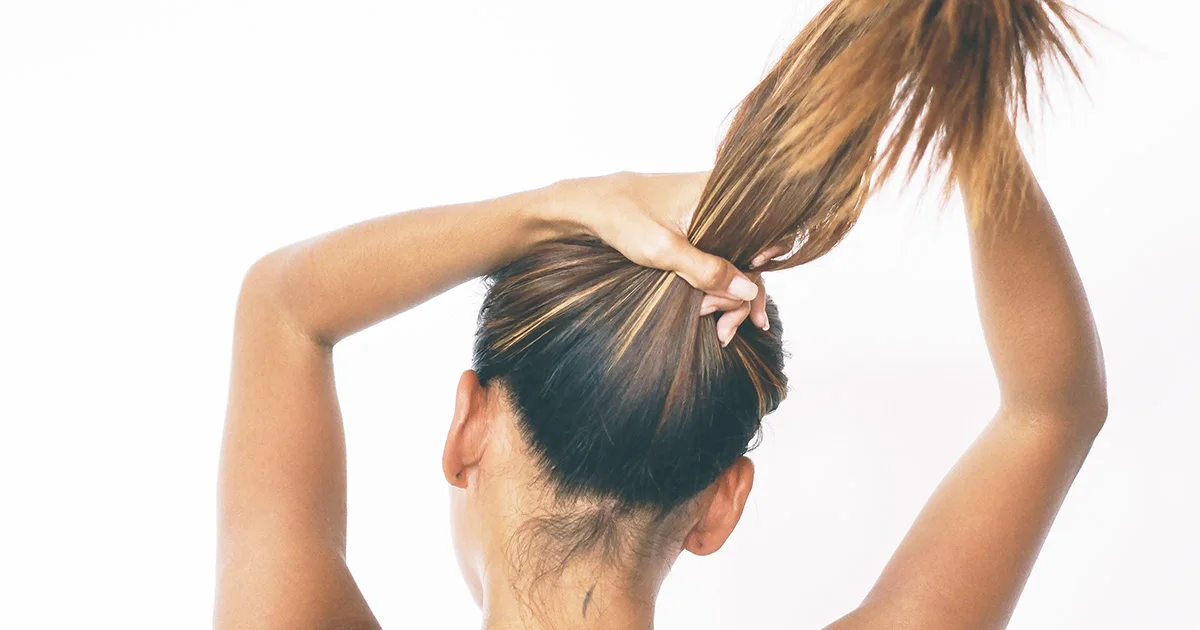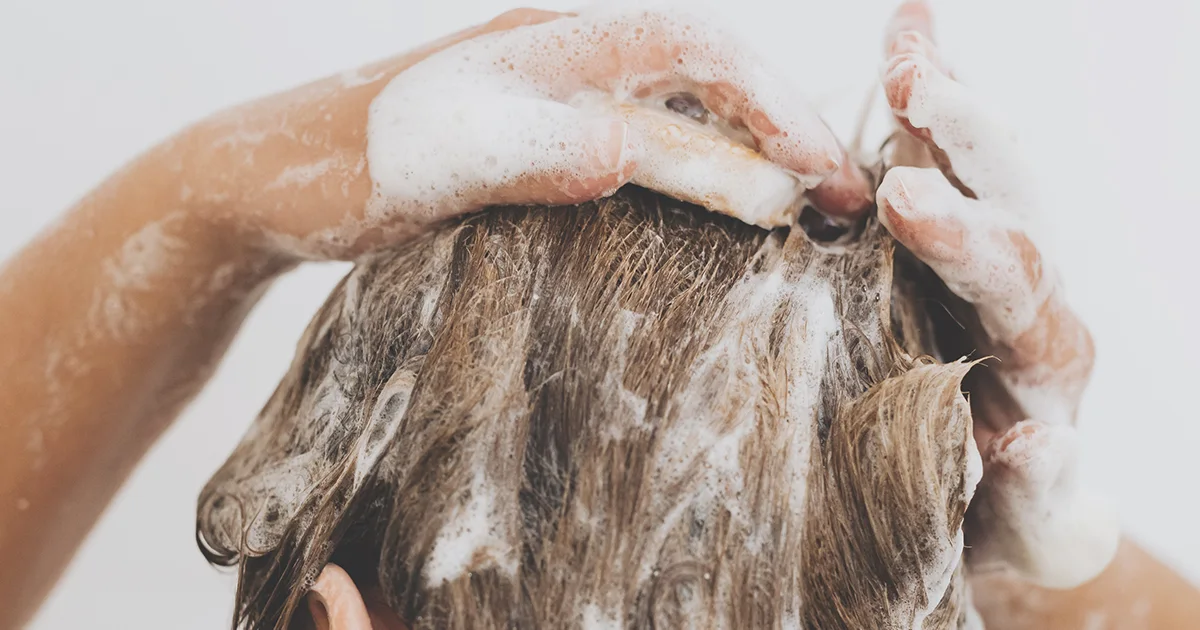Here's what we'll cover
Here's what we'll cover
We all lose dozens of hairs from our heads every day. So how do you know when hair loss is just typical shedding or when it crosses the line into full-fledged balding? Adult hair loss can begin at any age, from late teens to older adulthood. The earlier you catch it, the more likely it is that you’ll be able to slow down or reverse hair loss (if that’s what you want).
Hair loss can impact all people but is typically more common in men. Androgenetic alopecia, more commonly known as “male pattern baldness,” typically occurs on the top and front of the head at the hairline. In people assigned female at birth, hair thinning typically occurs on the top of the head starting with the hair part, leaving the hairline unchanged.
Continue reading to learn about early signs of balding and what you should know—including how you can slow down or stop balding, and possibly even regrow lost hair.
8 early signs of balding
The shift from a full head of hair to noticeable balding is gradual, so it may sneak up on you. Recognizing the early signs of hair loss may mean you can still slow down or reverse hair loss, if that’s what you want. Here are eight early signs that it might be time to intervene.
1. Receding hairline
A receding hairline is a classic early sign of balding. You’ll notice the signs of a receding hairline if your hair begins to thin at the temples, creating a more prominent widow’s peak and a hairline that resembles the letter M or a horseshoe. Alternatively, your hairline might seem to recede or thin all the way across.
Keep in mind that a widow’s peak is a dominant genetic trait. If you’ve always had a widow’s peak and don’t see changes in your hairline, a widow’s peak in and of itself is no cause for concern.
2. More hair loss than usual
Discovering a few hairs in your comb, on your pillow, or in the shower drain isn’t necessarily a sign that you’re going bald. The scalp contains about 100,000 hairs, and we lose about 100 hairs each day. That’s part of the natural life cycle of hair—scalp follicles are continually in the process of growing hair, pausing, and shedding.

But over time, if you notice that you seem to be shedding more hair than usual, it could be an early sign that your hair is permanently thinning.
3. Hair loss at the crown of the head
Another common early sign of balding is hair loss at the crown of the head. Hair at the crown (the back part of the top of the head) becomes sparser until the classic bald spot is evident. Because you don’t have eyes in the back of your head, you might want to use a hand mirror and the bathroom mirror to keep an eye on the area.
4. Hair seems thinner overall
Sometimes, balding doesn’t begin at the hairline or crown but develops and advances at a steady rate along a larger area of your scalp. This is sometimes called “invisible balding” because the hair loss is so gradual and balanced it may be hard to notice until nearly half the hair is lost.
5. The photographic evidence is adding up
If you suspect you may be balding but are unsure, take a look at photos of yourself over time. Compare a current photo of yourself with past photos taken in similar lighting and at a similar angle. This can give you a fresh perspective on any potential changes in your hairline or overall hair thickness.
6. Hair takes longer to grow
One effect of androgenetic alopecia is that the hair’s growth cycle becomes shorter. The normal growth cycle of a hair lasts between two and six years, after which the hairs fall out, and the cycle starts again with new hair growth. So the maximum length your hair can grow is determined by how long your growth cycle lasts and how quickly your hair grows.
If you used to easily grow longer locks and found yourself frequenting the barber shop but now you’re struggling to gain length with longer jaunts between cuts, this could be an early sign of balding.
7. Your barber or stylist notices a change
Everyone’s hair is a bit different. But anyone who’s been cutting hair for a while has seen it all. If you’re unsure how you’re stacking up, ask. If you’ve been going to the same barber or stylist for years, they might be able to tell you if they’ve noticed changes in your hair density over time. They can also advise you on the best hairstyles and styling tips for thinning hair.
8. Widening part
Another form of hair loss more common in women begins at the part in your hair. You may notice the gap where your hair falls to either side at the top of your head slowly becoming wider and spreading across your scalp.
What causes balding?
The vast majority of the time, thinning hair results from androgenetic alopecia, which affects all people, regardless of sex. Androgenic alopecia is linked to DHT (dihydrotestosterone), a potent form of testosterone found in higher levels as we get older.
Androgens contribute to masculine physical characteristics, such as larger muscle mass and a deeper voice, though they’re found in women as well, where they help promote growth, bone strength, and more. While high levels of testosterone in the bloodstream contribute to thicker facial hair and body hair, for reasons researchers don’t entirely understand, the hormone can sometimes damage hair follicles on the scalp and cause them to shrink. This process is called follicular miniaturization, and it causes the follicle to produce shorter, thinner hairs.
In some cases, androgenetic alopecia can start early—some studies show that it affects up to 16% of men between the ages of 18 and 29. But it’s much more common in older adults, with the likelihood increasing with age. White men are most affected, with 50% of men showing signs of balding by age 50.
Other causes of thinning hair
Most hair thinning and hair loss is genetic. However, there are some less common causes of hair loss to be aware of:
Breakage of the hair shaft—Damage to hair from dyeing or styling can cause the hair shaft to break off, resulting in sparser-looking scalp hair.
Alopecia areata—This autoimmune condition can cause hair loss in patches throughout the body. In extreme cases, a person might lose all body hair.
Vitamin deficiencies—In rare cases, a lack of nutrients such as B vitamins, vitamin D, iron, or zinc can cause hair loss.
Traction alopecia—This type of hair loss occurs when hair is chronically pulled too tight, such as in a ponytail or braids.
Telogen effluvium—Some people experience a general thinning of hair several months after severe physical or emotional stress. This type of hair loss is most often temporary but is also common after giving birth, for example, when it’s called postpartum hair loss.
Medications—Certain drugs can cause hair loss, such as those used to treat cancer, heart problems, high blood pressure, arthritis, and depression.
How to stop thinning hair
If you’re experiencing hair loss, there are several ways you can stem the loss and increase hair growth. The only FDA-approved medications for hair loss are minoxidil and finasteride, but other treatments have been shown to be effective in some cases.
Finasteride (brand name Propecia)
This oral prescription medication is FDA-approved to help slow hair loss and stimulate hair regrowth in men with androgenic alopecia. It blocks the conversion of testosterone to DHT, which can prevent further hair loss. It is the most effective drug for treating androgenetic alopecia, preventing further hair loss in 83% of men treated for two years.
It shouldn’t be used (or even touched) by anyone who could become pregnant since it can cause abnormalities in the fetus.
There are also topical finasteride preparations available in spray form that can offer some of the same effectiveness without any of the side effects common to finasteride pills.
Minoxidil (brand name Rogaine)
This liquid or foam is rubbed onto the scalp. If you opt for Rogaine, have patience–it can take about four months of continuous use to see results. It is most effective when used in combination with finasteride. We don’t know exactly how minoxidil stops hair loss, but it is believed to increase blood flow to the hair follicles. And just as there is topical finasteride in addition to the oral option, there’s an oral version of minoxidil that can be prescribed off-label for hair loss.
Low-level laser therapy
Low-level laser therapy (LLLT) is an FDA-cleared treatment for hair loss. Researchers don’t know exactly why it works, but LLLT may trigger the hair follicle stem cells to stimulate new hair growth. One review of studies found it to effectively promote hair growth in men with male pattern hair loss.
DHT-blocking shampoo
Several varieties of shampoo claim to block DHT's effect on miniaturizing follicles, but they're considered less effective than minoxidil or finasteride. Some contain zinc, vitamin B12, or ketoconazole (the active ingredient in the dandruff shampoo Nizoral). Ketoconazole, in combination with finasteride, may be more effective at reducing hair loss than finasteride alone, but scientific evidence doesn’t show that other common ingredients in DHT blocker shampoos cause hair regrowth.
PRP (platelet-rich plasma) treatments
Several dermatologists and hair-replacement specialists offer this treatment. A patient's own blood is drawn and placed in a centrifuge to extract plasma (the liquid component of blood), which is then injected into the scalp. The theory is that the growth factors in platelets can spur hair growth. Studies have shown varying results, and PRP is not FDA-approved for hair loss at this time.
Hair transplants
Hair transplantation is a surgical procedure that moves hair from one place on the scalp to another. The most dramatic results are seen when trying to correct a receding hairline. This makes it a good choice for improving androgenetic alopecia.
Whether you’re experiencing hair loss at your hairline, the crown of your head, or your hair part, you’re not alone. Hair loss can take you by surprise and have a negative impact on your self-confidence. If you’re concerned about hair loss, make an appointment with your healthcare provider to develop a safe and effective treatment plan. Check out the online telehealth option Ro, which can offer you a comprehensive hair loss consultation and treatment plan, all from the comfort of your home.
DISCLAIMER
If you have any medical questions or concerns, please talk to your healthcare provider. The articles on Health Guide are underpinned by peer-reviewed research and information drawn from medical societies and governmental agencies. However, they are not a substitute for professional medical advice, diagnosis, or treatment.
Finasteride Important Safety Information: Read more about serious warnings and safety info.
Oral Minoxidil Important Safety Information: Read more about serious warnings and safety info.
Adil, A. & Godwin, M. (2017). The effectiveness of treatments for androgenetic alopecia: A systematic review and meta-analysis. Journal of the American Academy of Dermatology, 77(1), 136–141. doi:10.1016/j.jaad.2017.02.054. Retrieved from https://www.ncbi.nlm.nih.gov/pubmed/28396101
Gentile, P., Cole, J., Cole, M., et al. (2017). Evaluation of not-activated and activated PRP in hair loss treatment: role of growth factor and cytokine concentrations obtained by different collection systems. International Journal of Molecular Sciences, 18(2), 408. doi:10.3390/ijms18020408. Retrieved from https://www.ncbi.nlm.nih.gov/pubmed/28216604
Ho, C., Sood, T., & Zito, P. (2021). Androgenetic alopecia. StatPearls. Retrieved from https://pubmed.ncbi.nlm.nih.gov/28613674/
Hugo Perez, B. S. (2004). Ketocazole as an adjunct to finasteride in the treatment of androgenetic alopecia in men. Medical Hypotheses, 62(1), 112–115. doi:10.1016/s0306-9877(03)00264-0. Retrieved from https://www.sciencedirect.com/science/article/abs/pii/S0306987703002640
Kaufman, K. D., Rotonda, J., Shah, A., & Meehan, A. G. (2008). Long-term treatment with finasteride 1 mg decreases the likelihood of developing further visible hair loss in men with androgenetic alopecia (male pattern hair loss). European Journal of Dermatology, 18(4), 400–406. doi:10.1684/ejd.2008.0436. Retrieved from https://www.ncbi.nlm.nih.gov/pubmed/18573712
Murphrey, M. B., Agarwal, S., & Zito, P. M. (2021). Anatomy, hair. StatPearls. Retrieved on Mar. 1, 2022 from https://www.ncbi.nlm.nih.gov/books/NBK513312/
Phillips, T. G., Slomiany, W. P., & Allison, R. (2017). Hair loss: common causes and treatment. American Family Physician, 96(6), 371–378. Retrieved from https://pubmed.ncbi.nlm.nih.gov/28925637/
Rhodes, T., Girman, C. J., Savin, R. C., et al. (1998). Prevalence of male pattern hair loss in 18-49 year old men. Dermatologic Surgery: Official Publication for American Society for Dermatologic Surgery, 24(12), 1330–1332. doi:10.1111/j.1524-4725.1998.tb00009.x. Retrieved from https://journals.lww.com/dermatologicsurgery/Abstract/1998/12000/Prevalence_of_Male_Pattern_Hair_Loss_in_18_49_Year.9.aspx
Sato, A. & Takeda, A. (2012). Evaluation of efficacy and safety of finasteride 1 mg in 3177 Japanese men with androgenetic alopecia. The Journal of Dermatology, 39(1), 27–32. doi:10.1111/j.1346-8138.2011.01378.x. Retrieved from https://pubmed.ncbi.nlm.nih.gov/21980923/
Shapiro, J. & Kaufman, K. D. (2003). Use of finasteride in the treatment of men with androgenetic alopecia (male pattern hair loss). The Journal of Investigative Dermatology. Symposium Proceedings, 8(1), 20–23. doi:10.1046/j.1523-1747.2003.12167.x. Retrieved from https://www.sciencedirect.com/science/article/pii/S0022202X15529357
Zito, P. M. & Raggio, B. S. (2021). Hair transplantation. StatPearls. Retrieved on Mar. 1, 2022 from https://www.ncbi.nlm.nih.gov/books/NBK547740/










